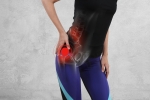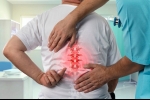Home »
Blog » Back Pain
| Stem Cell, PRP, Acupuncture in Queens & Long Island, New York
Back Pain | Stem Cell, PRP, Acupuncture in Queens & Long Island, New York
Tags: Back Pain | Posted on: 22-Jan-2021 | No of views: 3312 When you sleep, you lose conscious control over your body, and you can end up twisting your spine or tucking your pelvis in. Existing back pain can get further aggravated, resulting in a restless night of sleep. Using supported sleeping postures can prevent the concentration of stresses on your spine, keep your back relaxed, and create a healing environment. As a general rule, avoid sleeping on your stomach it disturbs the normal alignment of your spine. Also avoid sleeping on the side that hurts more, especially if you have sciatica.
Read more
Tags: Back Pain | Posted on: 20-Jan-2021 | No of views: 3545 Fast-acting pain treatments that target nerves in a specific part of the body - Nerve blocks are versatile treatments used by pain specialists to diagnose and treat a wide range of painful conditions. They reduce acute pain due to injury, nerve trauma, surgery, and headaches. They are also used to alleviate chronic pain, in conditions like carpal tunnel syndrome, arthritis, neuralgia, cancer, and Complex Regional Pain Syndrome (CRPS). Whether you are experiencing a new injury, a flare-up of an old injury, or an ongoing pain issue, nerve blocks can provide a faster and more comfortable recovery.
Read more
Tags: Back Pain | Posted on: 15-Jan-2021 | No of views: 3251 There are a number of back pain and related conditions that women are more susceptible to developing. Moreover, for women, back pain is more likely to become chronic over time. Several conditions are more common (and can be exclusive) in women. Back pain-related problems are typically seen in the post-menopausal age (above 50 years). Read on to learn more about the common causes of back pain in women and the reasons why they occur.
Read more
Tags: Back Pain | Posted on: 13-Jan-2021 | No of views: 3393 Significantly Reducing Lower Back, Leg, & Foot Pain. Lumbar sympathetic injections can determine if the sympathetic nerves in the lumbar (lower) spine are the cause of your pain issues. Lumbar Sympathetic Injection Facts & Information - If you are suffering from pain or weakness in your lower back, legs, or feet, you know how these symptoms can have a major impact on your quality of life. Lumbar sympathetic injections can determine if the sympathetic nerves in the lumbar, or lower, spine are the cause of your problems and treat the inflammation in order to relieve the pain.
Read more
Tags: Back Pain | Posted on: 08-Jan-2021 | No of views: 3767 Sciatica is common, affecting 10% to 40% of the population. Despite it being commonplace, many myths and misconceptions persist and, in turn, make it hard for people with sciatica to get better. Here are 10 definitive facts about sciatica to quickly get you up to speed:
1. Sciatica Overlaps with Multiple Diagnoses
2. Sciatica Refers to A Set of Symptoms
3. Level of Spinal Nerve Involvement Matters...
Read more
Tags: Back Pain | Posted on: 01-Jan-2021 | No of views: 3613 Most episodes of acute lower back pain are caused by damage to your soft tissues, such as the muscles and/or ligaments that support your lumbar spine. A common injury is a lower back strain, but it’s popularly referred to as a pulled muscle. The pain resulting from a lower back strain can be surprisingly severe, sending many patients to the emergency room.
Read more
Tags: Back Pain | Posted on: 30-Dec-2020 | No of views: 3255 Hip Joint Injections - Each year, thousands of people find that hip pain has made activities they used to welcome such as outings, exercise, and time with family/friends a chore. If you have hip pain, non-surgical treatment options should be considered first. Hip joint injections have revolutionized the treatment of hip pain and other areas affected by that pain, such as the lower back, buttock, or leg.
Read more
Tags: Back Pain | Posted on: 25-Dec-2020 | No of views: 3749 Our backs crack for myriad reasons. But what is making this sound? And when should it concern me? Read on to learn about what makes the cracking sound when you twist or bend your spine when the sound is normal, and when it may indicate a developing problem in the joints, bones, and/or muscles of your spine. The cracking, popping, or grating that you experience under your skin is called crepitus and usually originates from your joints, but may also develop within your bursae, tendons, or other soft tissues.
Read more
Tags: Back Pain | Posted on: 23-Dec-2020 | No of views: 3530 Relief from Joint Pain and Inflammation in the Neck and Back. Facts and Information - The facet joints are found in the spine, where they connect the backbones to each other. They allow the spine to bend and twist. Like a knee or hip, facet joints have cartilage between the bones and a fluid-filled capsule to allow for smooth movement. When damaged, facet joints can cause debilitating pain in the neck or back. This condition is known as Facet Syndrome. It may occur due to an injury, overuse, or the onset of an inflammatory condition.
Read more
Tags: Back Pain | Posted on: 18-Dec-2020 | No of views: 3718 A foam roller also called a styrofoam cylinder, may help you reduce pain, tender spots, and stiffness in your neck and upper back. Keep the following tips in mind when you use a foam roller to stretch your muscles or perform a self-massage. Roll Out Your Knots - Slowly roll the foam roller until you find a tender spot or trigger point. Then apply gentle, steady pressure to that spot until the pain subsides, but no longer than 60 seconds.
Read more
Love this Post? Spread the World






















